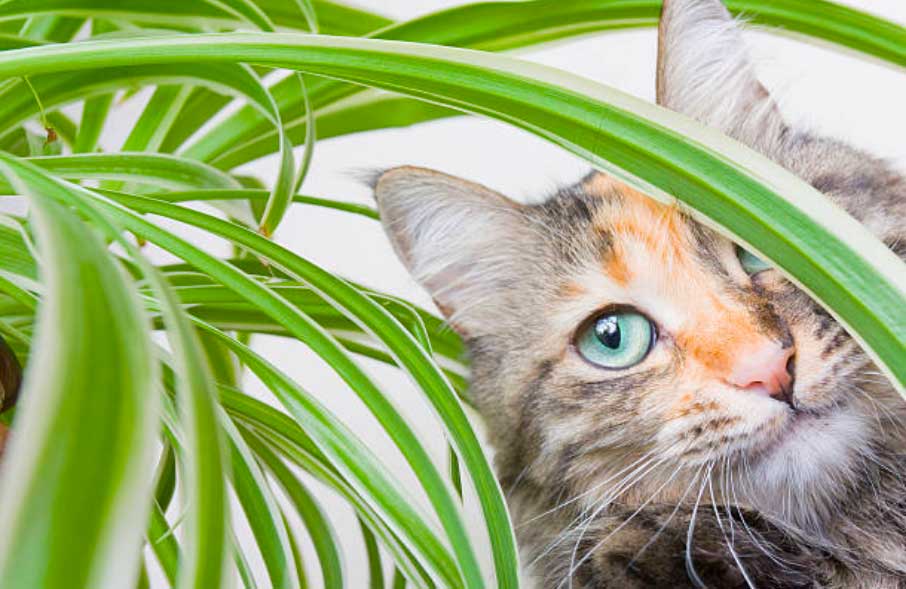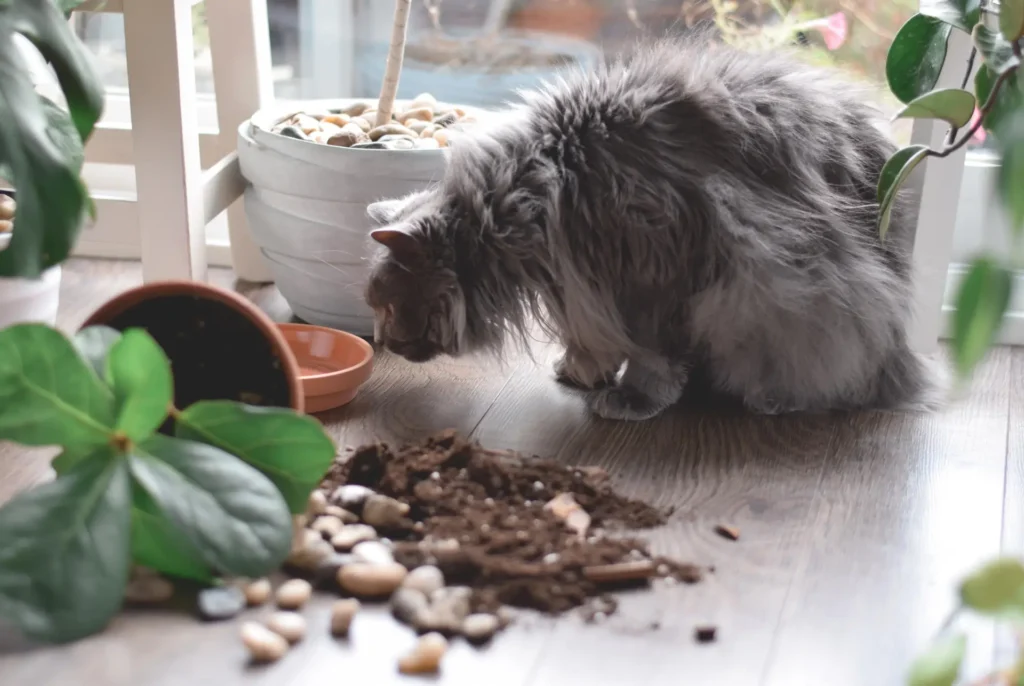To prevent cats from pooping in your house plants, you can follow several strategies. First, choose cat-safe plants to reduce their attraction to your greenery. Place plants in areas that are difficult for your cat to reach, such as high shelves or hanging from the ceiling. Create physical barriers using rocks, wire mesh, or plant protectors. Ensure your cat has access to a clean and appealing litter box to make it a more attractive option. You can use commercial cat repellent sprays or granules, or try natural deterrents like citrus scents or aluminum foil on the soil.
Furthermore, keep your cat engaged with toys and playtime to reduce boredom, and consider positive reinforcement for appropriate behavior. With patience and consistency, you can train your cat to avoid your houseplants. If the problem persists, consult a veterinarian or animal behaviorist for guidance.
How do cats’ instincts affect their behavior with house plants?

Cats are known for their unique and sometimes perplexing behaviors. To effectively prevent them from pooping in house plants, it’s crucial to delve deeper into their motivations and instincts. Understanding the reasons behind this behavior is a significant step towards finding appropriate solutions.
Natural Instincts
Cats are naturally inclined to dig and bury their waste, which stems from their evolutionary history as solitary hunters. In the wild, this behavior helps them avoid detection by predators or competitors.
House plants, with their loose, soft soil, mimic the texture of outdoor soil, making them an attractive option for cats to use as makeshift litter boxes.
Territorial Marking
Cats have a strong territorial instinct and may use their feces as a way to mark their territory, especially if they perceive a threat or change in their environment.
House plants can become a target for this marking behavior, particularly if the plants are new or if there are other pets in the house.
Recognizing the role of territorial marking in this behavior can lead to strategies to make your cat feel more secure and less inclined to mark your plants.
Health Issues
Sometimes, cats may resort to inappropriate elimination due to underlying health issues, such as urinary tract infections, gastrointestinal problems, or stress-related conditions.
Before assuming the behavior is purely behavioral, it’s essential to rule out any potential medical causes.
Monitoring your cat’s overall health and consulting a veterinarian if necessary is a critical part of addressing the problem effectively.
The Importance of Understanding Cat Behavior
Understanding the underlying motivations and instincts of your cat’s behavior is fundamental to implementing the right prevention and modification strategies.
Without this understanding, attempts to prevent cats from pooping in house plants may be futile or even counterproductive.
By empathizing with your cat’s natural tendencies and addressing their needs, you can create an environment that is both cat-friendly and conducive to the well-being of your house plants.
What are effective methods to prevent cats from soiling house plants?
Preventing cats from using house plants as litter boxes is essential for maintaining a clean and harmonious living environment. To achieve this goal, a combination of practical solutions and strategies is required. Here, we’ll explore these strategies in detail:
Choose Cat-Safe Plants
Cats are naturally curious and may chew on or nibble house plants. Some plants are toxic to cats and can lead to health issues if ingested.
Opt for cat-safe plants like spider plants, Boston ferns, or catnip, which are non-toxic and less likely to pique your cat’s interest.
Research cat-safe plant options to ensure your indoor garden is safe for your feline friend.
Create a Designated Litter Box Area
Cats need a designated and accessible area for their litter box. Ensure it’s located in a quiet, low-traffic spot, away from their food and water bowls.
Use a litter box that suits your cat’s preferences in terms of size, type of litter, and cleanliness. Regularly clean the litter box to maintain a hygienic and inviting space for your cat.
Use Cat Deterrents
Employ cat deterrents like motion-activated sprays, mats with textures cats dislike (e.g., aluminum foil), or scents that are unappealing to cats (e.g., citrus).
These deterrents create negative associations with your house plants and can discourage cats from using them as litter boxes.
Employ Positive Reinforcement
Positive reinforcement involves rewarding your cat for using the designated litter box and refraining from pooping in the plants.
Offer treats, praise, and affection when your cat uses the litter box correctly, reinforcing the idea that this is the preferred location for elimination.
Employ Physical Barriers
Place physical barriers around your house plants to make them less accessible to your cat. Use items like plant stands, decorative rocks, or wire mesh.
These barriers prevent cats from reaching the soil while preserving the aesthetic appeal of your indoor garden.
Maintain Clean Litter Boxes
Cats are more likely to use a clean litter box. Regularly scoop waste, change litter as needed, and wash the box periodically to keep it fresh and inviting. Maintaining a clean litter box is crucial for encouraging your cat to use it consistently.
Consistency and Patience
Consistency is key in training your cat to use the litter box. Stick to a regular feeding and cleaning schedule.
Be patient and avoid punishing your cat for accidents. Negative reinforcement can lead to anxiety and avoidance behaviors.
How to modify a cat’s behavior regarding house plants?
Addressing a cat’s behavior and redirecting their natural instincts away from house plants requires thoughtful training and behavior modification. Here are the key strategies for achieving this:
Clicker Training
Clicker training is a positive reinforcement method that uses a clicker and treats to reinforce desired behaviors.
To train your cat away from pooping in house plants, start by associating the clicker sound with treats. Then, use the clicker to mark and reward good behavior, such as using the designated litter box.
Over time, your cat will learn to connect the desired behavior with the reward, making them more likely to choose the litter box over your plants.
Reward-Based Training
Reward-based training involves offering treats, praise, or affection when your cat exhibits the desired behavior.
When your cat uses the litter box correctly, immediately reward them with a treat and positive attention. Be consistent in your rewards to reinforce the message that using the litter box is the right choice.
Consistency in Correction
Correcting undesirable behavior is just as important as rewarding positive behavior.
When you catch your cat attempting to use house plants as a litter box, interrupt the behavior calmly but firmly. Use a loud “No” or a similar cue to communicate that this action is not acceptable.
It’s essential to correct the behavior every time you catch it to establish a consistent message.
What are the best practices for protecting house plants from cats?

To prevent cats from pooping in your house plants, it’s essential to make your indoor greenery less appealing to them. This can be achieved through proper plant care and strategic placement. Here are the key strategies to make house plants less enticing to your feline companions:
Use Safe Repellents
Safe and cat-friendly repellents can be applied to house plants to deter cats from approaching them. These repellents typically emit scents that cats find unpleasant.
Examples of cat-safe repellents include citrus-scented sprays, vinegar solutions, or commercial pet repellent sprays.
Be cautious when choosing repellents to ensure they are non-toxic to both your cat and your plants.
Cover the Soil with Deterrents
Cats are often attracted to the loose, inviting soil in houseplants. To deter them from digging and using the soil as a litter box, cover it with deterrents. Options include placing aluminum foil, large river rocks, or pine cones on the surface of the soil.
These materials create an uncomfortable texture that discourages cats from scratching or digging.
Prune and Maintain Plants
Overgrown plants with hanging or trailing leaves can be tempting for cats to play with and hide in. Regularly prune and maintain your house plants to reduce their attractiveness as a play area for your cat.
Trim excess foliage and ensure there are no loose leaves that could serve as a potential litter box.
Place Plants Out of Reach
One of the most effective ways to keep cats away from house plants is to position the plants out of their reach. Place plants on high shelves, ledges, or suspended from the ceiling to make them inaccessible to your cat. Ensure that the plants are secure to prevent accidents.
FAQ’s
How do I keep cats out of my house plants?
You can place rough-textured materials, like aluminum foil or pine cones, on the soil to deter cats from digging in your plants.
How do I stop my cat from digging in my potted plants?
Use a natural deterrent like coffee grounds or citrus peels in the pots to discourage digging.
What smells keep cats away from plants?
Cats dislike the smell of citrus, lavender, rosemary, and eucalyptus, so incorporating these scents near your plants can help deter them.
What natural cat repellent is safe for plants?
Natural cat repellents like diluted lemon or vinegar sprays are generally safe for plants and can deter cats.
Can you spray lemon juice on plants to keep cats away?
Yes, you can dilute lemon juice with water and spray it on or around plants to keep cats away.
What smells do cats not like?
Cats typically dislike the scents of citrus, lavender, rosemary, and eucalyptus, which can be used as natural repellents.
Final Words
Preventing cats from pooping in your house plants requires a multifaceted approach that considers both the feline instincts and behavior modification. Choosing cat-safe plants, creating a designated litter box area, and employing cat deterrents can help reduce the appeal of your house plants to your cat.
Positive reinforcement, consistency, and patience play a crucial role in training your cat to use the litter box consistently. Clicker training and reward-based training are effective methods for redirecting their behavior.
